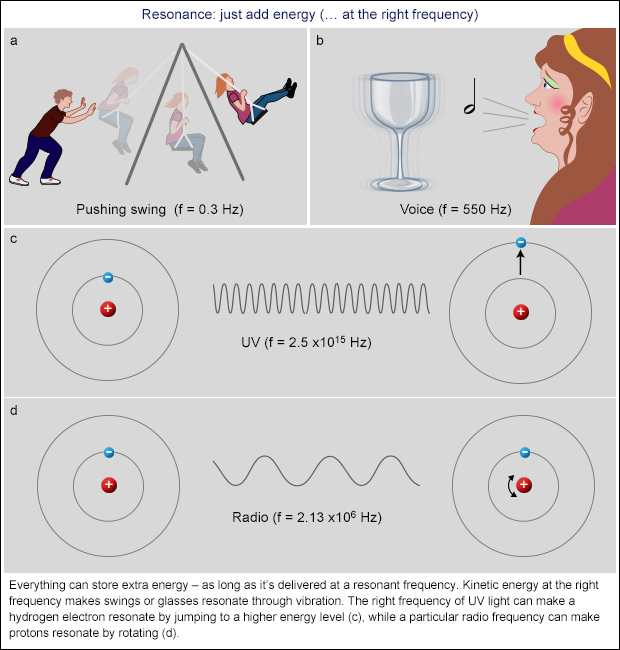Science News
& Faculty Articles
Evidence of Resonant Waves Found in Rat Brain Activity

By Dr. Inés Urdaneta, Physicist at Resonance Science Foundation
Using ultrafast and ultrahigh field magnetic resonance imaging (fMRI), researchers at the Champalimaud Foundation and the University of Minho have found evidence of resonant waves in rat brain activity. This means that the brain seems to be a resonant chamber where distant brain areas show correlated activations due to collective wave modes [1].
Many theoretical works have proposed models based on standing waves to explain the macroscopic patterns observed [2-5], though the nature of such activations remains unclear. To delve deeper into this mechanism and understand how distant areas exhibit signal correlations, and how they are implicated in brain function, experimental evidence required a better temporal resolution of the fMRI spectras to show the spatial pattern oscillations and prove the hypothesis that these macroscopic patterns result from the distinct or independent transient oscillation modes at...
Rhythmic Oscillations and Resonant Information Transfer in Biological Macromolecules

By: William Brown, scientist at the Resonance Science Foundation
This report has been published as a science article review and can be accessed freely at the online journal Qeios- Click here to access the article
In the book Rhythmic Oscillations in Proteins to Human Cognition [1], a compendium of avant-garde researchers takes a fresh look at the mechanics of nature to emphasize the importance of cyclical, harmonic interrelationships of oscillatory phenomena, especially in biophysics and biochemistry. The book is part of a larger series of publications set to explore and document fundamental research carried out globally from astrophysics to particle physics, from stock market to economic theories, and from plant biology to consciousness. The editors Anirban Bandyopadhyay, a senior Scientist at the National Institute for Materials Science (NIMS) in Tsukuba, Japan— whose patents include a time crystal model for building an artificial human brain [2]— and Kanad Ray,...
On the Stability of Slowly Rotating Kerr Black Holes

By Amal Pushp, Affiliate Physicist at the Resonance Science Foundation
A black hole is a solution to Einstein’s general relativistic field equations. Based on the property of angular momentum, black holes can be categorized into two types: non-rotating and rotating. The former is described by the Schwarzschild solution and the latter by the Kerr solution, originally named after its discoverers.
Perhaps all physical systems tend to move towards equilibrium irrespective of their initial conditions and similar is the case with black holes. A long-standing problem in black hole physics concerns the stability of these great astrophysical voids. The idea is to regain the original state of the black hole after the effect of an externally applied perturbation has faded away. This proves that the black hole is indeed stable. The case otherwise is an instability and would be quite a task in that it would compel us to modify Einstein’s theory.
Addressing this unsolved...
Additional Commentary on the Stimulated Unruh Effect: Studying Quantum Effects in Gravitational Fields

By: William Brown, Biophysicist at the Resonance Science Foundation
In a previous article RSF physicist Dr. Ines Urdaneta discussed a proposed study for probing the Unruh effect with quantum optics [1]. Because of the importance of experiments that will probe quantum effects in gravitational fields and to further elucidate the nature of the quantum vacuum, we will take another look at this proposed experiment and expound on some of the key insights of the study.
As Dr. Urdaneta explained in the previous article, the importance of probing the Unruh effect has to do with its relationship to quantum gravitational effects via the equivalence principle first described by Albert Einstein. Einstein is well known for his seminal work on the theory of relativity, which regards the behavior of clocks and rulers under accelerating and non-accelerating frames of reference, and the relativity of simultaneity that results from the invariance of the speed of light relative to any...
What is Resonance and Why is it so Important?

Image: Linden Gledhill, a Philadelphia-based pharmaceutical biochemist creates incredible cymatic pattterns with sound, water and light.
By Inés Urdaneta, Physicist at Resonance Science Foundation
Resonance is experienced, and even identified as the process being responsible for the forms of what we perceive, observe, or infer based on it - an atom, a flower, planets, galaxies -. It binds together the different elements that make up physical reality and allows interaction between them. It is the main factor for feedback to be possible, the conduit, shall we say, through which the exchange of information happens: the external can penetrate the internal, and the internal can manifest outside. The condition for that channel to be available, is the coincidence in energy; that the inner and outer energies are compatible. i. e., that they have the same frequency.

Source of Image: https://www.abc.net.au/science/articles/2014/06/16/4022877.htm
In general, we...
Collective Molecular Resonance Key to Long-Range Intermolecular Interaction in the Cell

By: William Brown, Biophysicist at the Resonance Science Foundation
The discovery of completely new and unanticipated forces acting between biomolecules could have considerable impact on our understanding of the dynamics and functioning of the molecular machines at work in living organisms. [1]
Every second within the cells of your body there are billions of biochemical reactions taking place, including at least 130,000 protein-to-protein and protein-to-DNA interactions that are key to cellular functionality—regulating homeostasis, metabolism, biosynthesis, replication, and growth. How is this staggering level of activity coordinated in such a remarkable fashion within the cellular environment? Which as described, is quite crowded with myriad proteins, solutes, metabolites, and other biomolecules. In current models, there are no explanations for the remarkable level of coordination—the innumerable biomolecules are thought to jostle around haphazardly under...



